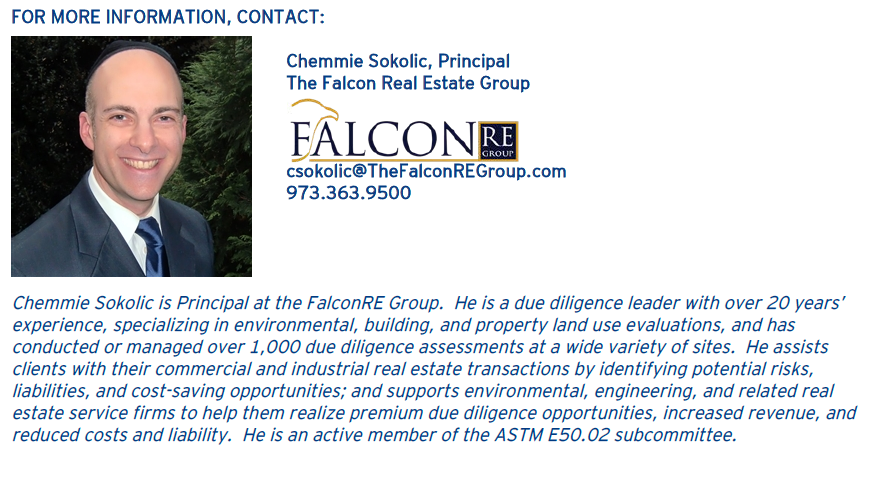The Upcoming Revised Phase I ESA (Environmental Site Assessment) Standard
 Over the next weeks and months, you’ll likely be hearing much discussion about the imminent revised and updated ASTM E1527 Phase I Environmental Site Assessment (Phase I ESA) standard. The Phase I ESA standard is the due diligence scope of work that prospective purchasers of commercial and industrial properties generally require before finalizing a real estate transaction, and is designed to provide certain environmental legal protections under the Comprehensive Environmental Response, Compensation, and Liability Act of 1980 (“CERCLA”) *. A Phase I ESA is also commonly used or even required by investors and financial institutions as a tool to assess relative environmental risk of a parcel or parcels of real estate.
Over the next weeks and months, you’ll likely be hearing much discussion about the imminent revised and updated ASTM E1527 Phase I Environmental Site Assessment (Phase I ESA) standard. The Phase I ESA standard is the due diligence scope of work that prospective purchasers of commercial and industrial properties generally require before finalizing a real estate transaction, and is designed to provide certain environmental legal protections under the Comprehensive Environmental Response, Compensation, and Liability Act of 1980 (“CERCLA”) *. A Phase I ESA is also commonly used or even required by investors and financial institutions as a tool to assess relative environmental risk of a parcel or parcels of real estate.
The New Phase I ESA Standard (PDF)
Since 1993, the Phase I ESA standard has come to be recognized as the defining standard of what comprises “good commercial and customary standards and practices” for conducting environmental due diligence. ASTM International, the organization that develops such standards, is required to review and either revise or reissue the existing version of its ASTM E1527 Phase I ESA standard no later than every eight years. Since the current version was last updated in 2013, it was time for a reassessment, and, over the last few years, members of the ASTM E50.02 subcommittee, such as myself, have been hard at work examining numerous sections of the standard to bring it up to date with what constitutes good commercial and customary practice in 2021. These revisions may impact prospective purchasers as they navigate their commercial and industrial real estate transactions, as well as their ability to receive financing on real estate transactions.
This article discusses and summarizes some of the more significant changes to the standard.
So, What’s Changed?
Definitions of REC, CREC, and HREC
Arguably, one of the most important terms of a Phase I ESA is the “Recognized Environmental Condition” (REC), and the associated “Controlled Recognized Environmental Condition” (CREC) and “Historical Recognized Environmental Condition” (HREC); these are the conditions that indicate the subject property is, was, or may be impacted by contamination. The definition of all three terms have been revised in the upcoming standard, but, though the words have changed, the concepts and ramifications of these definitions haven’t (assuming a correct understanding these terms in the first place).
Phase I ESA – Instructions and Clarifications
The new standard now includes additional and more robust instructions and clarifications to aid the practitioner regarding key terms such as “review of land title records” (two methods have been provided to meet the requirements, and clarification that records must be reviewed back to at least 1980); “property use limitations”; “likely”, “significant data gaps”; and “presumed viability” of the assessment (i.e., the relative “shelf life” of the report).
Additionally, the level of inquiry at a subject property has been clarified to potentially be different depending on the future intended uses of the subject property, as disclosed to the environmental professional, so every
practitioner should be aware of the correct questions to ask and not be shy about asking them. For example, the environmental professional’s conclusions regarding prior environmental remediation at a currently
industrial subject property may be differently affected depending on whether the future use of the property is expected to remain as is – i.e., industrial – or whether it will be converted into a school or multi-family residence.
Again, however, though additional clarifications have been provided, no substantive changes from the 2013 standard have been made. Historical Research One of the more potentially contentious set of changes in the standard includes those revisions to the historical research section. In addition to a significant revision of the section layout, the standard will now clarify that:
1. Properties may be different in use, size, configuration, or address than in the past, and that practitioners should consider these changes when conducting their research;
2. Aerial photographs, fire insurance maps, local street directories, and historical topographic maps must be reviewed if, based on the judgment of the environmental professional, they are reasonably ascertainable, likely to be useful, and applicable to the subject property, though there is some recourse if such resources are not reviewed; and
3. If the above four historical resources were researched for the subject property (and provide coverage of one or more adjoining properties, and are likely to be useful in satisfying the historical research section objective), they should also be reviewed for the adjoining properties; again, there is some recourse if such resources were not reviewed.
It is important for users of Phase I ESA reports to note, however, that though it seems additional work is now required as compared with the 2013 standard, it is likely that experienced and quality consultants have already been conducting such historical research during their assessments, and the new standard probably won’t affect their typical level of inquiry.
Site Reconnaissance
The section outlining the site reconnaissance requirements has been greatly revised and trimmed in content, but not in substance. However, it should be noted that the Phase I report should now describe which of the specified features, activities, uses, and conditions both were and were not present at the subject property, rather than only describing them if they were or were likely present.
Site Plan and Photographs
Two notable additions in a Phase I report will include a site plan (showing the approximate location of features, activities, uses, and conditions of the subject property), and photographs (showing features, activities, uses, and conditions indicative of RECs and de minimis conditions, and other relevant and representative photographs deemed pertinent by the environmental professional). Once again, however, it should be noted that most quality Phase I ESA reports typically already include these items.
Opinions Are Required, Recommendations Are Not
The new standard will clarify that, as with the current standard, an opinion provided in the report that additional investigation may be appropriate is different than a recommendation that provides a specific course of action which is outside the scope of the Phase I ESA standard. Users should still feel free to ask their consultant to provide such recommendations, if so desired, because such advice can help inform subsequent business decisions, but don’t expect these recommendations to be included in the report proper unless requested and contracted with the consultant ahead of time.
Emerging Contaminants
The new standard clarifies that certain hazardous substances (including some substances sometimes generally referred to as “emerging contaminants”) are not included in a Phase I ESA unless or until such substances are classified as a CERCLA hazardous substance. This applies to such “new” contaminants as per- and polyfluoroalkyl substances (PFAS). However, that doesn’t necessarily mean that such substances are not a concern at the subject property *. Users and consultants should be aware of the limitations of a Phase I ESA, and be mindful of the ultimate objective(s) of any due diligence conducted.
Revised and Supplemental Appendices
The appendices in the standard have undergone a thorough overhaul including an updated legal appendix, and additional elucidation in the suggested Table of Contents appendix. Furthermore, a very useful new appendix has been added that explains and describes the REC definition, and includes a logic flow diagram that will help some practitioners determine what is and is not a REC; numerous explanatory examples are also provided in this new appendix.
At the end of the day, what does all of this mean to you?
Probably not much if you’ve been retaining experienced consultants who conduct thorough assessments and generate good quality reports that adhere to the 2013 standard; though there have been many changes made to the 2013 standard, most of them are largely non-substantive. However, there will likely be consultants in the industry who now have to “elevate” the scope and quality of the work they do, and may increase their prices accordingly. On the other hand, higher quality assessments will likely not necessitate much of a price increase, if any.
As has always been the case, it is recommended that users retain an experienced consultant whom they trust and with whom they feel comfortable, who knows and understands the Phase I ESA standard, and is familiar with what protections and information it does and doesn’t provide, so that you obtain the answers and data you need to make wise and informed business decisions.
It is expected that the new Phase I standard will be finalized and promulgated in or around November 2021. Please don’t hesitate to reach out to me with questions related to proposed revisions to the Phase I ESA standard or to discuss impacts to your specific real estate transactions in greater detail.
* The current and prior versions of the E1527 standard state that other federal, state, or local laws may impose environmental assessment obligations that are beyond the scope of [the Phase I] practice. A note has been added to the new standard reiterating that, if a Phase I ESA is being conducted to satisfy state requirements and to qualify for the state (or other jurisdiction) equivalent landowner liability protections (LLPs), users and environmental professionals are cautioned and encouraged to consider any differing jurisdictional requirements and definitions while performing the Phase I ESA, and that users may decide to expand the scope of the Phase I ESA. In New Jersey, for example, this typically includes the completion of a Preliminary Assessment (and potentially a Site Investigation, as well), i.e., in addition to a Phase I ESA for federal LLPs.




